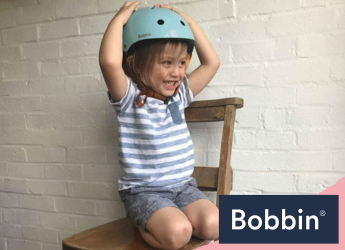Why Do Toddlers Need Bike Helmets?
Toddlers have an insatiable curiosity and boundless energy. And this makes their exploration of the world around them an awe-inspiring journey. However, this journey is not without its risks.
When it comes to outdoor activities like biking, their safety takes centre stage. Little ones are particularly vulnerable to accidents, especially those involving head injuries. Cue toddler helmets.
In this blog, we’ll explore the importance of wearing Bobbin helmets. Read on and discover how these headgears can provide your little ones with protection.
Brain Development and Vulnerability
(Starling Bike Helmet Duck Egg Blue)
During the toddler years, a child’s brain undergoes rapid growth. This shapes their cognitive and motor skills. Thus, safeguarding their developing brains is paramount.
Toddlers’ skulls, being thinner and less dense, offer less protection against impact. Even minor falls can have disproportionately severe consequences.
Recognising this fragility underscores the importance of kids helmets as essential guardians. The same goes for getting the right size bike helmet.
Role and Structures of Helmets
Helmets, in general, work by absorbing and dissipating impact forces. The outer shell disperses the initial shock. Meanwhile, the inner foam liner absorbs energy, preventing it from reaching the skulls.
Child-sized head protections incorporate lightweight materials. Such a feature ensures comfort and minimises strain on their developing neck muscles. Their construction also includes an impact-resistant outer shell. Paired with a soft cushioned inner lining, these additions promise enhanced protection. Adjustable straps, snug fits, and ventilation systems also ensure proper fit and airflow. This pink bike helmet makes an excellent example.
Overall, the intricate design reduces head injury risks by cushioning potential blows. Moreover, it allows toddlers to ride their balance bikes with safety and confidence.
Legal and Safety Standards
(Starling Bike Helmet Green with Multi Stars)
Wearing helmets isn’t just good practice; it’s often legally mandated by “kids on bike rules”. In the UK, legal regulations stipulate that children under 14 must wear one while cycling. The headgear must also adhere to recognised safety standards, such as the BS EN 1080:2013. These standards guarantee helmets are rigorously tested for impact resistance and fit snugly.
Choosing helmets that meet these stringent criteria is essential. Invest in those high-standard designs to ensure their little adventurers are well-guarded.
Setting a Safety Example
The influence of parental actions extends beyond words, shaping kids’ attitudes towards safety. So when parents don helmets while cycling, they set a compelling example for toddlers. This emphasises that safety isn’t a compromise but a non-negotiable practice.
Eventually, children internalise these behaviours. And this encourages them to prioritise protection from an early age. This positive influence fosters a culture of safety consciousness, where helmet-wearing becomes the norm.
Parental helmet use, therefore, is key to safety-conscious young cyclists.
Addressing Common Concerns
Parents’ concerns about toddler helmet use are understandable. Some worry about discomfort curbing their kid’s enjoyment or resistance to wearing one. To address these concerns, consider these practical tips:
1. Choose comfortable helmets
Opt for lightweight helmets with soft padding and adjustable straps for a snug yet comfy fit. Use our “how should bike helmet fit” guide for reference.
2. Make it a routine
Introduce helmets as an essential part of the cycling routine from an early age. This will make it a familiar and expected practice for toddlers.
3. Involve them in the selection
Allow toddlers to pick helmets with fun colours or designs. Doing so will give them a sense of ownership and excitement. Top tip: Make sure to match their chosen shade with this best colour bike selection.
4. Lead by example
When parents wear helmets enthusiastically, children are more likely to follow suit.
5. Gradual introduction
Start with short rides in a safe environment. Then, gradually increasing duration to help toddlers adapt.
6. Praise and positive reinforcement
Acknowledge and celebrate helmet use. Reinforce its importance and make it a positive experience.
Round-up
In the exhilarating journey of toddlerhood, safety must stand as our unwavering companion. Cue a toddler cycle helmet, which can transform potential mishaps into carefree explorations. For ultimate road protection, equip toddlers with bells bike and bike lights.
Moving on: Do Adults Need to Wear Bike Helmets?












